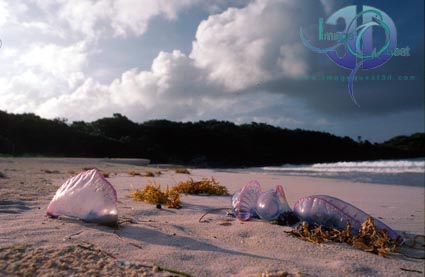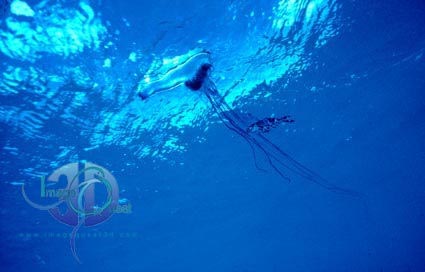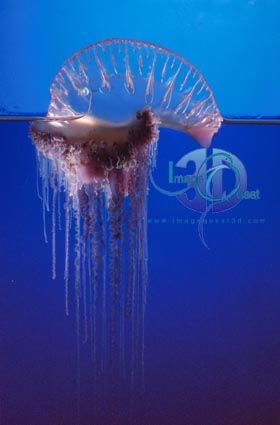|
Brilliant blue sea, white coral sand - some even say "pink" sand
and, arguably, the world's most evocative seabird, the long-tail
- these characteristics epitomise Bermuda, that mid ocean mountain
that played a small but significant role in the colonization of
the New World.
Try visiting the island in a mid winter storm and the characteristics
are very different - grey skies, howling winds, never a seabird
in sight and sand littered with flotsam, jetsam and Sargassum.
None the less, if you want to see some of the most unbelievably
beautiful oceanic life forms - visit Bermuda while some of those
winter storms are still in action.
With this in mind, several years ago, we mounted a marine expedition
to Nonsuch Island, 3 miles off the coast of Bermuda, for March/
April. Four weeks into the six, late one afternoon I ventured
down to South Beach to monitor the tide line. A moderate, on shore
storm was blowing itself out and the surf was raging ashore, bringing
with it and the wind all sorts of debris. I wasn't interested
in the inanimate junk - I was on the look out for members of a
community that are genuine surface drifters, animals that are
designed to take anything that Mother Nature hurls at them in
the way of wind and weather. They can cope with nearly everything……except
that is being stranded by an onshore gale or storm. For this reason,
tide-line scavenging is a great way to learn a little of what
is happening at sea - without risking life and limb on board boat!

Stranded Portuguese Man-O-War (Physalia physalis)
As I came down onto the beach, it was very obvious that large
numbers of Portuguese Man-O-War, Physalia physalis, were coming
ashore and being left by a falling tide. I strolled the "death"
zone. Most of the victims were still very much alive. The floats
were writhing in a vain attempt to regain the surf. I have always
been interested in colour variation in Physalia and this was a
great opportunity to compare many individuals in close proximity
to one another. I stooped closely to inspect one writhing individual.
From somewhere behind me I heard a staccato rattling sound. I
swung round. Just sand, sea and stranded men-o-war. Again I bent
low to turn over a particularly beautiful purple Physalia. Again
the rattling sound - but this time further down the beach. I rounded
towards the sound in time only to see two more men-o-war dumped
unceremoniously on the streaming sand. Perhaps I had imagined
the sound, or more likely it was the wind getting under a bit
of polythene flotsam. Anyway, back to more important things. Dozens
of Physalia were in the bay now and I doubted if any would escape
this miserable and ignominious end to a life of perfect freedom
such as they must all have known. I stood and watched them drifting
ever shoreward. I was tempted to rush to the rescue of each and
every one - hurling them back into the surf but, like beached
whales, they would have come straight back in.
Suddenly more slapping right behind me. I turned more cautiously,
only in time to see a large Prussian blue man-o-war skid to a
standstill as the water receded through its flaccid tentacles
to leave it mortally marooned, like so many of its kind before.
There was something slightly spooky about the sound now - as
the light began to fail, the wind began to howl and the sea boiled
ever more furiously across the breadth of the bay. The next time
I would be ready for it. I stood like a stag anticipating the
hunt, straining to hear a sound that came and went before I could
identify even its position, let alone its cause. I must have waited
five minutes or more. Suddenly I heard the rattling behind me.
I spun just in time to see a large man-o-war being plastered to
the still streaming sand and there amongst its tentacles a fish
- slapping its tail for all it was worth. Its efforts drove it
down the beach until the depth of draining water was sufficient
to float it free and back to the open sea. Now it all became plain.
Drifting ashore in the storm were men-o-war, some of which were
accompanied by their commensal nomeid fish - beautiful navy blue
and silver Nomeus gronovii. These valiant and faithful little
associates were so attached to their particular Physalia that
they would risk death sooner than abandon their comrade - only
at the very last minute, striking for their lives to regain the
open sea.

Portuguese Man-O-War (Physalia physalis)
& commensal fish (Nomeus gronovii)
Of all the demonstrations of animal association this occurrence
has impressed me more than any. The whole subject of symbiosis
and commensalism is shrouded in mystery and our knowledge of what
really goes on is mostly misinformed guesswork, but here is one
outstanding demonstration of the strength of the bond between
animals of two widely different phyla and habit.
As I watched yet another demonstration take place I could only
think of the phrase slap happy, but this was clearly not. This
was slap-unhappy.
This article was written by Peter Parks
If
you have an article of general interest that you would like considered
for the article of the month then we would love to hear from you.
If you are also able to supply images then we can include those
as well. You can email us at iq3d@imagequest3d.com
|

